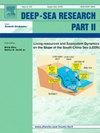How do macrobenthic-based indices respond to anthropogenic pressures? Insights from estuaries of the Persian Gulf and Gulf of Oman
IF 3
3区 地球科学
Q2 OCEANOGRAPHY
Deep-sea Research Part Ii-topical Studies in Oceanography
Pub Date : 2025-04-11
DOI:10.1016/j.dsr2.2025.105481
引用次数: 0
Abstract
Coastal ecosystems are increasingly threatened by human activities, necessitating effective monitoring tools to assess their ecological health. This research examines the ecological conditions of three estuaries along the Persian Gulf and Gulf of Oman, focusing on the impacts of human activities over a one-year period by utilizing macrofauna as biological indicators. Samples of macrofauna and sediment were collected from nine distinct sites, reflecting a range of contamination levels from industrial wastewater and shrimp farming to relatively unaffected areas. A total of 165 macrobenthic taxa were identified across seven groups: Annelida and Mollusca each had 65 taxa, Arthropoda had 28, Echinodermata had 3, Hydrozoa had 2, and both Nemertea and Nematoda had 1 each. The most common group was Polychaeta, accounting for 37.57 % of the total, followed by Gastropoda at 22.42 %. The ecological condition and sediment quality were assessed using biotic and heavy metal indices, specifically the AMBI and the potential ecological risk index (PERI). The analysis revealed that industrial sewage and effluents from shrimp farming are significant pollution contributors in the Khamir and Tiyab estuaries, respectively, leading to notable declines in biodiversity indices (P ≤ 0.05). The AMBI index exhibited a strong negative correlation with species richness and Shannon and Margalef indices, while positively correlating with total organic matter (TOM). Heavy metal concentrations were found to be elevated in contaminated sites, further indicating ecological stress. The results suggest that the AMBI index is a valuable tool for assessing coastal ecosystem conditions, effectively distinguishing between less affected and heavily impacted areas, and can support coastal monitoring efforts. Additionally, Capitella capitata and Clymene robusta showed resilience to pollution, while Assiminea sp. And Littorina intermedia were sensitive to environmental disturbances. These findings can inform more efficient and targeted management strategies for coastal areas, emphasizing the importance of monitoring heavy metal levels in maintaining ecological health.
大型底栖生物指数如何应对人为压力?波斯湾和阿曼湾的入海口
沿海生态系统日益受到人类活动的威胁,需要有效的监测工具来评估其生态健康状况。本研究利用大型动物作为生物指标,考察了波斯湾和阿曼湾沿岸三个河口的生态状况,重点研究了人类活动在一年时间内的影响。从9个不同的地点收集了大型动物和沉积物样本,反映了从工业废水和虾养殖到相对未受影响地区的一系列污染水平。7个类群共鉴定出165个大型底栖动物类群,其中环节动物和软体动物各65个,节肢动物28个,棘皮动物3个,水螅动物2个,线虫和线虫各1个。最常见的是多毛纲,占总数的37.57%,其次是腹足纲,占总数的22.42%。采用生物指数和重金属指数(AMBI)和潜在生态风险指数(PERI)对生态条件和沉积物质量进行评价。结果表明,工业污水和对虾养殖出水分别是Khamir河口和Tiyab河口的主要污染源,导致生物多样性指数显著下降(P≤0.05)。AMBI指数与物种丰富度、Shannon指数和Margalef指数呈显著负相关,与总有机质(TOM)呈显著正相关。污染场地重金属浓度升高,进一步表明生态压力。结果表明,AMBI指数是评估沿海生态系统状况的一个有价值的工具,可以有效区分受影响较小和受影响严重的地区,并可以支持沿海监测工作。此外,小头草(Capitella capitata)和克莱门草(Clymene robusta)对污染表现出恢复力,而小头草(asiminea sp.)和小枝草(Littorina intermedia)对环境干扰较为敏感。这些发现可以为沿海地区更有效和更有针对性的管理战略提供信息,强调监测重金属水平对维持生态健康的重要性。
本文章由计算机程序翻译,如有差异,请以英文原文为准。
求助全文
约1分钟内获得全文
求助全文
来源期刊
CiteScore
6.40
自引率
16.70%
发文量
115
审稿时长
3 months
期刊介绍:
Deep-Sea Research Part II: Topical Studies in Oceanography publishes topical issues from the many international and interdisciplinary projects which are undertaken in oceanography. Besides these special issues from projects, the journal publishes collections of papers presented at conferences. The special issues regularly have electronic annexes of non-text material (numerical data, images, images, video, etc.) which are published with the special issues in ScienceDirect. Deep-Sea Research Part II was split off as a separate journal devoted to topical issues in 1993. Its companion journal Deep-Sea Research Part I: Oceanographic Research Papers, publishes the regular research papers in this area.

 求助内容:
求助内容: 应助结果提醒方式:
应助结果提醒方式:


